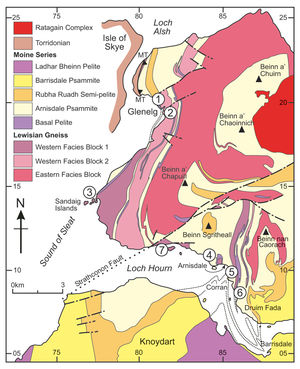Moine geology of West Glenelg and Loch Hourn - an excursion
| From: Strachan, Rob, Friend, Clark, Alsop, Ian, Miller, Suzanne (Editors). A Geological excursion guide to the Moine geology of the Northern Highlands of Scotland.: Edinburgh Geological Society, Glasgow Geological Society in association with NMS Enterprises, 2010. |
By John Ramsay


Excursion 6 West Glenelg and Loch Hourn is composed of the following articles:
- Excursion 6 West Glenelg and Loch Hourn - introduction
- West Glenelg. Localities 6.1 to 6.3
- Loch Hourn region. Localities 6.4 to 6.7
Excursion 6 West Glenelg and Loch Hourn
| Purpose: | To examine relationships between Moine metasediments and Lewisianoid basement rocks above the Moine Thrust, and the nature of the polyphase deformation that affects both units. |
| Aspects covered: | Lewisian orthogneisses and associated mafic intrusions (locally eclogitic), Moine psammites and sedimentary structures, polyphase folds and fabrics. |
| Useful information: | Hotel and B&B accommodation are available in and near Glenelg village. |
| Maps: | OS: 1:25,000 sheet 413 Knoydart, Loch Hourn and Loch Duich; BGS: 1:50,000 sheet 71E Kyle of Lochalsh. |
| Type of terrain: | Rocky coastline. |
| Distance and time: | The excursion is best followed over 2 days; Localities 6.1-6.3 can be visited on the first day and 6.4-6.7 on the second. |
| Short itinerary: | For visitors only interested in Moine-Lewisian relations, Localities 6.1, 6.3 and 6.6 can be completed in a single day. |
This is a classic region for establishing the differences between Lewisian basement and Moine metasediments above the Moine Thrust. These are especially apparent in the west of the region but are progressively overprinted towards the east by the effects of superimposed (Caledonian?) deformation and metamorphism. Detailed descriptions, maps and structural analysis relevant to this excursion are provided by Peach et al. (1910), Ramsay (1958), Sutton & Watson (1959) and Ramsay & Spring (1962).
The Lewisian gneisses comprise ‘Western’ and ‘Eastern’ facies (Fig. 6.1). Both are dominated by acid and mafic orthogneisses, but the Eastern facies is particularly distinctive because of the presence of metasediments and eclogites (see also Excursion 7). The Lewisian rocks are found in three strips (Fig. 6.1) which are interpreted as the cores of D1 anticlines. The two western fold cores are of Western facies aspect (Fig. 6.1) and the third is of Eastern facies aspect (Fig. 6.1). The Moine rocks comprise a well-defined stratigraphic sequence of psammites, semi-pelites and pelites that has been assigned to the Morar Group (Fig. 6.1). Towards the east, the Moine rocks become progressively migmatitic.
Three major deformation phases have been recognized in the Lewisian and Moine rocks (Fig. 6.2). The Lewisian and Moine were interfolded by D1 tight to isoclinal folds (Fig. 6.2). Fold-axis parallel lineations are mainly quartz rods that probably formed at no higher than the low amphibolite facies. D2 folding resulted in the Beinn a’ Chapuill-Beinn nan Caorach Antiform and the Glen Beag Synform ((Fig. 6.2), BC and GB respectively) as well as numerous associated minor folds. D2 folding was accompanied by strong recrystallization and migmatization of both Lewisian and Moine. A strong axial-planar schistosity is present and a prominent D2 lineation is parallel to local D2 fold axes. D3 folds trend NE-SW and have axial planes that dip SE. The most important regional folds are the Loch Hourn-Loch Duich anti-form and the Ben Sgriol Synform ((Fig. 6.2), LH-LD and BS). D3 folds crenulate earlier fabrics and were probably accompanied by low amphibolite facies metamorphism.
References
| At all times follow: The Scottish Access Codeand Code of conduct for geological field work |